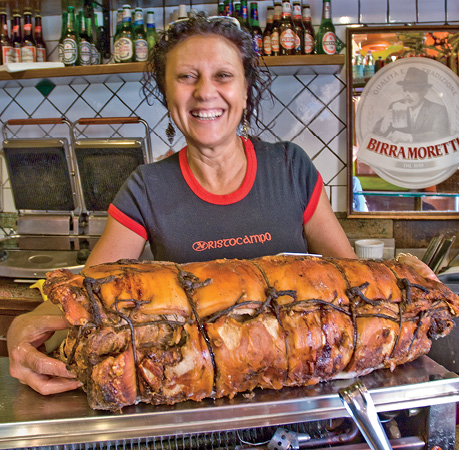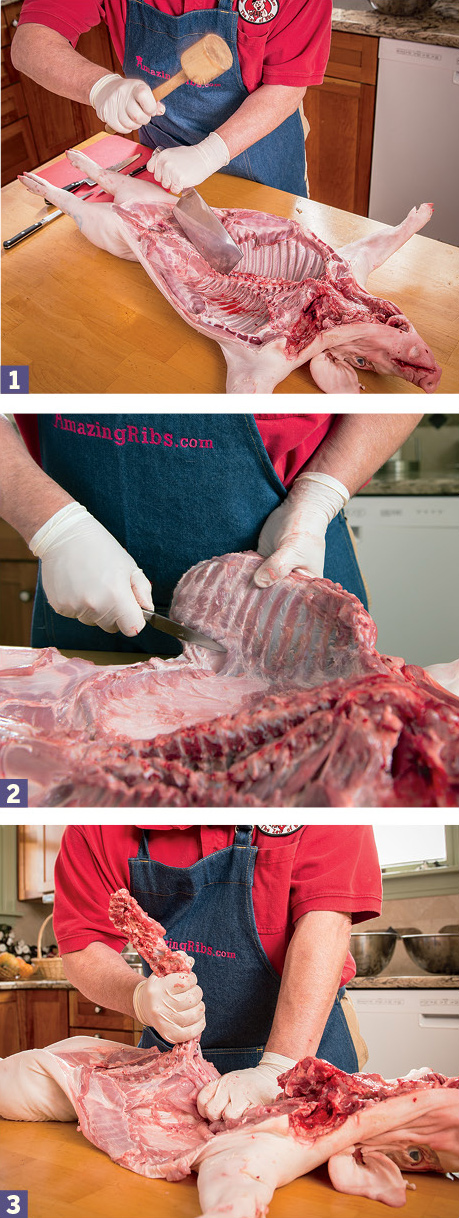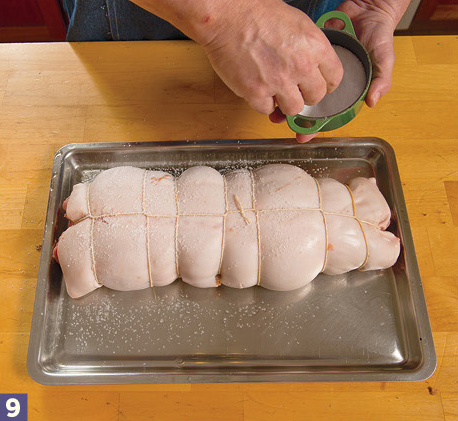
Suckling Porchetta
Across Italy they make some of the tastiest pork you can imagine, called porchetta. It features golden brown, exquisitely crispy pig skin wrapped around a tender, succulent, juicy, herbed pork loin. The fat layer under the skin melts and bastes the meat while it cooks over a hot wood fire. The concept goes back to the Roman empire, and porchetta is sold everywhere from white tablecloth restaurants to street vendors.
Each region prepares it a little differently. In many areas, porchetta is made from a huge whole hog, with the torso gutted and deboned and then stuffed with herbs, tongue, heart, liver, and kidneys. It is then stitched up and rotisseried in a wood-burning stove over a pan that collects the juices, which are used for basting. The skin is left on, encasing the meat in crunchy cracklins. That’s the way it is done in Costana in Umbria, near Assisi, where they have an annual festival to celebrate the dish, the Sagra della Porchetta, in late August. Just south of Rome, the town of Ariccia is to porchetta what Kansas City is to ribs, and commercial producers there ship it all over the country.
Pictured below is a porchetta stitched like a giant football at the Trattoria Aristocampo on the edge of the famous outdoor market, Campo di Fiori, in Rome. The pig comes from a supplier in Ariccia. The skin is as hard as candy, there is a thick layer of molten fat below it, and then tenderloin meat and a stuffing. Think of it as a giant pork sausage.
That’s a lot of meat and a lot of fat, so here’s a similar recipe made with a 25-pound suckling pig. When you order your pig, ask your butcher to remove all hair and split the breastbone and spine. A 25-pound pig yields almost 7 pounds of porchetta plus 2 quarts of silky bone broth (see page 220).
A plastic tablecloth is a good idea to reduce cleanup. You might need a clean hacksaw blade to cut through the breastbone. A cleaver or a sturdy chef’s knife comes in handy for cutting through the spine. You’ll also need a thin flexible sharp filleting knife, butcher’s twine or kite string, and two large bowls.

Makes 12 to 14 servings
Takes 6 to 8 hours
- 1 (25-pound) suckling pig
- Kosher salt
- ⅓ cup olive oil
- 2 large onions, coarsely chopped
- 1 pound plain crusty bread, chopped into ½-inch chunks
- ¼ cup fresh rosemary
- ¼ cup fresh oregano
- 2 tablespoons paprika
- 8 garlic cloves, minced or pressed
- Smoked Bone Broth (page 220; optional)

1. Prep. Lay a plastic tablecloth on your work surface. Put two large bowls on the tablecloth, one for meat and one for bones, skin, and trim.
2. Run your hand over the skin of the pig. If you feel any hair or stubble, remove it with a razor blade. You can also use a butane lighter to burn off the hair, but it will stink.
3. If it has not already been cleaved, cut through the breastbone, using a clean hacksaw blade, tin snips, or a cleaver (Picture 1). If your butcher hasn’t done so, cut the ribs off the spine with a heavy knife (2). Set them aside for making broth.
4. Pull the spine out (3). Salvage any meat and put it in the meat bowl. Discard the spine. You don’t want spinal cord in your broth.
5. Remove the tenderloins. Set them aside in the meat bowl. You will use them for the stuffing.

6. Remove the shoulders, front legs, and head by cutting through the shoulder joints (4). Remove the hind legs by cutting through the hip joints. Remove the hocks by cutting off the feet at the ankles. Pull the skin off the front and hind quarters (5).
7. Put the skin, bones, and hocks in the trim bowl. Remove all the meat from the bones in the hams and shoulders and put it in the meat bowl. Skin the head and get all the meat you can off it. There’s some tasty stuff in the cheeks and the tongue is good, but you have to remove the skin from it. The ears are rich in collagen, so set them aside in the trim bowl.
8. Look closely at the exposed meat on the remaining carcass. Cut out any bits of bone, veins, or glands (6).

9. Salt the interior generously. Get this done now so the salt can work its way into the meat. Chop the meat in the meat bowl into hunks 1 to 2 inches thick. Add the oil, onions, and bread. Mix in the rosemary, oregano, paprika, garlic, and about ½ teaspoon salt (7).
10. Lay down strings every 2 inches and place the center of the pig on them (8). Mound the meat mixture toward the center, roll it up, and tie it up with string. Tie off the ends.

11. Wet the skin thoroughly with a clean cloth or sponge. Soak it. Then sprinkle salt all over it, about 1 tablespoon per square foot (9). Don’t worry, a lot of it will fall or melt off, but the salty water helps break down the leathery skin and turn it into crunchy cracklins.
12. Fire up and cook. Get the smoker or grill preheated to 325°F in the indirect zone. Add wood for smoke and put the porchetta into the smoker, seam side up.
13. When the porchetta reaches about 150°F in the center, sear the skin by putting it on a griddle in the smoker or, better still, move it to a hot grill and, with the lid open, sear one side, roll it 90 degrees, sear, and repeat until all sides are dark brown and crispy and the interior is 160°F. You need to cook it that high because you have essentially made a giant sausage. But don’t worry, it will not be dry.
14. Serve. Snip off the strings and cut slices about ¾ inch thick. No gravy is needed, but if you happen to have a little Smoked Bone Broth, pour a little on the slices after you serve.